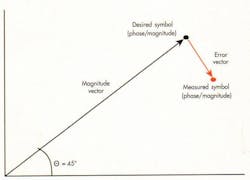Modulation, Symbols, And Bits: Building Your Wireless Vocabulary
Have you ever heard terms like modulation scheme, orthoganal frequency division multiplexing (OFDM), or symbol rate and scratched your head? As new wireless standards emerge, we get excited about the higher data rates they afford. Yet most people, even engineers, who get excited about these new technologies don’t truly understand why the new generation is better than the last.
Still, it’s important to understand how next-generation wireless standards are changing the way engineers design both radios and test equipment. At a high level, we’re mostly familiar with how wireless communications systems rely on radio waves traveling in free space. Perhaps this concept hits closest to home if you’re like me and are getting your HDTV over the air from an antenna. Of course, mine has a sweet built-in low-noise amplifier (LNA).
Radio waves at a particular frequency can travel large distances from the transmit antenna to the receive antenna. Effectively, we can think of the radio wave as a sinusoid, which has a given phase, magnitude (or power), and frequency at any given time. That brings us to the first concept of wireless communications: modulation.
Fundamentals Of Modulation
With radio wave modulation, a transmitter can use changes in phase, magnitude, or frequency to represent either analog or digital information. In one of the most basic modulation types, amplitude modulation (AM, as in AM radio), the transmitter will vary the magnitude of the transmitted signal so its envelope represents the audio signal being transmitted. We’d refer to AM modulation as an analog modulation type, since the audio signal being broadcasted is an analog one, not digital.
Digital modulation introduces a few new concepts. Again, changes in phase, magnitude, and frequency can be used to represent digital information. One of the most basic digital modulation schemes, amplitude shift keying (ASK), is frequently used in simple wireless systems such as RF car remotes and tire pressure monitoring systems.
In an ASK scheme, each transmitted bit—or in some cases groups of bits—is mapped to a particular state of the carrier wave. In a simple 2-ASK scheme, data is transmitted by varying the magnitude of the carrier where digital “0s” and “1s” are represented with high and low magnitude states of the carrier. The actual data rate of such a system is determined by the rate at which the carrier changes “state” from one magnitude to the other.
To use specific terms, the state of the carrier is called a symbol, and it’s defined as having a specific phase, magnitude, and frequency. Moreover, the rate at which the carrier changes state from one symbol to the next is called the symbol rate.
While ASK is one of the most basic modulation types, most wireless communication systems designed to achieve higher data rates use some form of quadrature amplitude modulation (QAM). With QAM systems, rather than using only two unique states of the carrier to transmit information (2-ASK), a symbol map might use 16, 64, or even 256 symbols, each having a unique combination of phase and magnitude.
When using a higher-order QAM scheme such as 64-state QAM (64QAM), each symbol represents a grouping of bits to be transmitted. In the case of 64QAM, each symbol has a 6-bit signature, implying that transmitted bits are grouped six at a time with each 6-bit grouping being translated to a specific symbol (Fig. 1).
Increasing Data Rates
Given the relationship between bits, modulation type, and symbols, we can next investigate ways to increase the data rate of a communication system. Clearly, “higher-order” modulation types such as 64QAM would produce higher data rates than simpler types such as 2-ASK or QPSK (quadrature phase shift keying—essentially 4QAM). For example, 256QAM enables a transmitter to send 8 bits per symbol (log2(256) = 8), while 2-ASK only allows one bit per symbol (log2(2) = 1).
In addition, one could imagine that the symbol rate would have an impact on data rate as well. The faster a transmitter switches from one symbol to the next (remember, this means transmitting a new phase/amplitude/frequency combination), the faster data can be transmitted on a given channel.
Next-generation communications systems such as LTE-Advanced and IEEE 802.11ac are achieving higher data rates through technologies such as carrier aggregation, orthogonal frequency division multiplexing (OFDM), and multiple-input-multiple-output (MIMO) antenna technology. Since each of these three technologies is a more advanced topic, let’s only investigate the effect of data rates and modulation type for now.
One of the most common “flavors” of 802.11, IEEE 802.11n, commonly has a 1x1 antenna configuration (single transmit and single receive antenna) using a 20-MHz channel. In this configuration, the maximum theoretical data rate of roughly 65 Mbits/s is achieved when using 64QAM.
By contrast, 802.11ac introduces a newer modulation type that, with all other things being equal, allows for higher data rates. When using ac’s 256QAM scheme, the same 20-MHz channel carries 8 bits per symbol instead of the 6 bits per symbol for 64QAM. With all other settings being equal, an 802.11ac channel with the same bandwidth and antenna scheme could produce a theoretical maximum data rate of 86.7 Mbits/s, exactly 33% higher.
In the context of OFDM standards such as LTE-Advanced and 802.11ac, the impact of symbol rate on data rate is slightly more difficult to understand. Unlike single-carrier transmission schemes, OFDM systems split data into multiple parallel subcarriers. The total data rate of a transmission is then computed by multiplying the data rate of each subcarrier by the total number of subcarriers. So unlike the transition from 2G to 3G cellular (both single-carrier systems), which used higher symbol rates to achieve higher data rate, OFDM systems generally just use more subcarriers.
For example, 802.11a/g/n/ac all utilize 312.5-kHz subcarriers. In 20-MHz configurations, a symbol rate of 312.5 kHz allows for 64 total subcarriers (20 MHz/312.5 kHz), and 52 of these will be allocated for transmitting data. Similarly, 802.11ac’s 160-MHz bandwidth configuration uses the same symbol rate for each subcarrier (312.5 kHz), but simply adds data rate (and hence bandwidth) by using more subcarriers.
As one might expect, a 160-MHz transmission uses 512 sub-carriers in parallel, allowing for eight times the data rate of a 20-MHz transmission. So the next time you hear about the possibilities of 802.11ac, you now know why it’s so exciting!
Why Testing Matters
Generally, we can think of the quality of an RF link as the ability of both the transmitter and receiver to preserve the desired phase, magnitude, and frequency of each symbol. On the transmit side, one of the most common measurements to characterize the quality of a transmitter is error vector magnitude (EVM).
Designers can measure EVM by using an RF signal analyzer and comparing the actual symbol location (measured phase and magnitude) of each symbol with the desired symbol location. It is expressed as a ratio of the magnitude of the error vector divided by the magnitude vector. In the example shown in Figure 2, the EVM of the measured symbol (in red) is approximately 25%.
On the receive side, the most fundamental measurement for a digital communication system is sensitivity. Transmitted waves traveling over long distances suffer from degraded signal-to-noise ratio (SNR), which becomes a factor in the receiver’s ability to demodulate a signal. In fact, the combination of the actual transmission’s SNR and the receiver’s inherent noise might prevent a receiver from correctly recovering the digital bits.
To test a receiver, an RF vector signal generator is used to generate an example transmission at a low power level, and the bit error rate (BER) is measured at the output of the receiver. As the signal generator’s output power is reduced, the BER logically increases.
In the end, sensitivity is defined as the lowest power level at which a receiver can maintain a “minimum BER.” For example, if 1% BER is considered the minimum acceptable performance, and a receiver can achieve it at –100-dBm input power, the sensitivity would be –100 dBm.
Parting Thoughts
Wireless communications systems are indeed complex—and the people tasked with their design and test use special words to describe them. I hope this tutorial demystifies some of the language RF engineers use and explains a few of its terms. So the next time you hear someone talking about the “black magic” of wireless communications, remember that everyone can understand the world of wireless.


